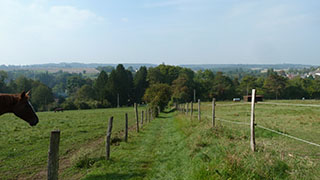Prochain point :
Ferme du Montoir- Agriculture et diversification
Prochain point : lat="49.0458" lon="1.8803"

The undulating landscape of French Vexin
A village in the hollow of three valleys
The territory of Seraincourt was shaped by three waterways (l’Eau Brillante brook, the Bernon and the Montcient), which dug their valleys out of the limestone plateau of French Vexin. Three hamlets, set in the valleys, make up the municipal area: the town, Rueil and Gaillonnet. The valley slopes are covered with pastures, gardens and a few orchards. The woodlands on the hills mark the shift to the dominant plateau, devoted to cereal farming. The dense former habitat was grouped around small farms. The urban fabric today is almost continuous between the town and the hamlet of Rueil.
Ancient history
The origin of the village dates back to prehistoric times. Archaeological excavations have unearthed Neolithic burial grounds, a Frankish cemetery and Gallo-Roman graves. Seraincourt and the hamlet of Rueil came under the bailiwick of Meulan and the diocese of Rouen. The hamlet of Gaillonnet was an independent lordship until the Revolution. The town of Seraincourt was then attached to the department of Seine-et-Oise. In the administrative reorganization of the Paris region in 1964, after hesitating between the departments of Yvelines and Val d'Oise, the town opted for the latter. In 1976, the last descendant of the Choppin family (Lords of Seraincourt) gave the municipality the right to use his coat of arms as the municipal emblem.
The old watercress fields
The Seraincourt watercress fields were farmed from the nineteenth century until the early 1990s. Known since ancient times, watercress is valued for its rich vitamins and trace elements. Growing watercress is a complex process. After germinating the seeds in a mixture of soil and sand, the trenches are filled with water to receive the young plants. The plants are later lifted and transplanted to a new trench, bunched in staggered rows. Watercress can be harvested from September to May, a month after transplanting (three months after sowing). Farmers used to sell their produce directly to the local inhabitants and in local markets. The watercress fields have now been converted into trout fishing ponds.





